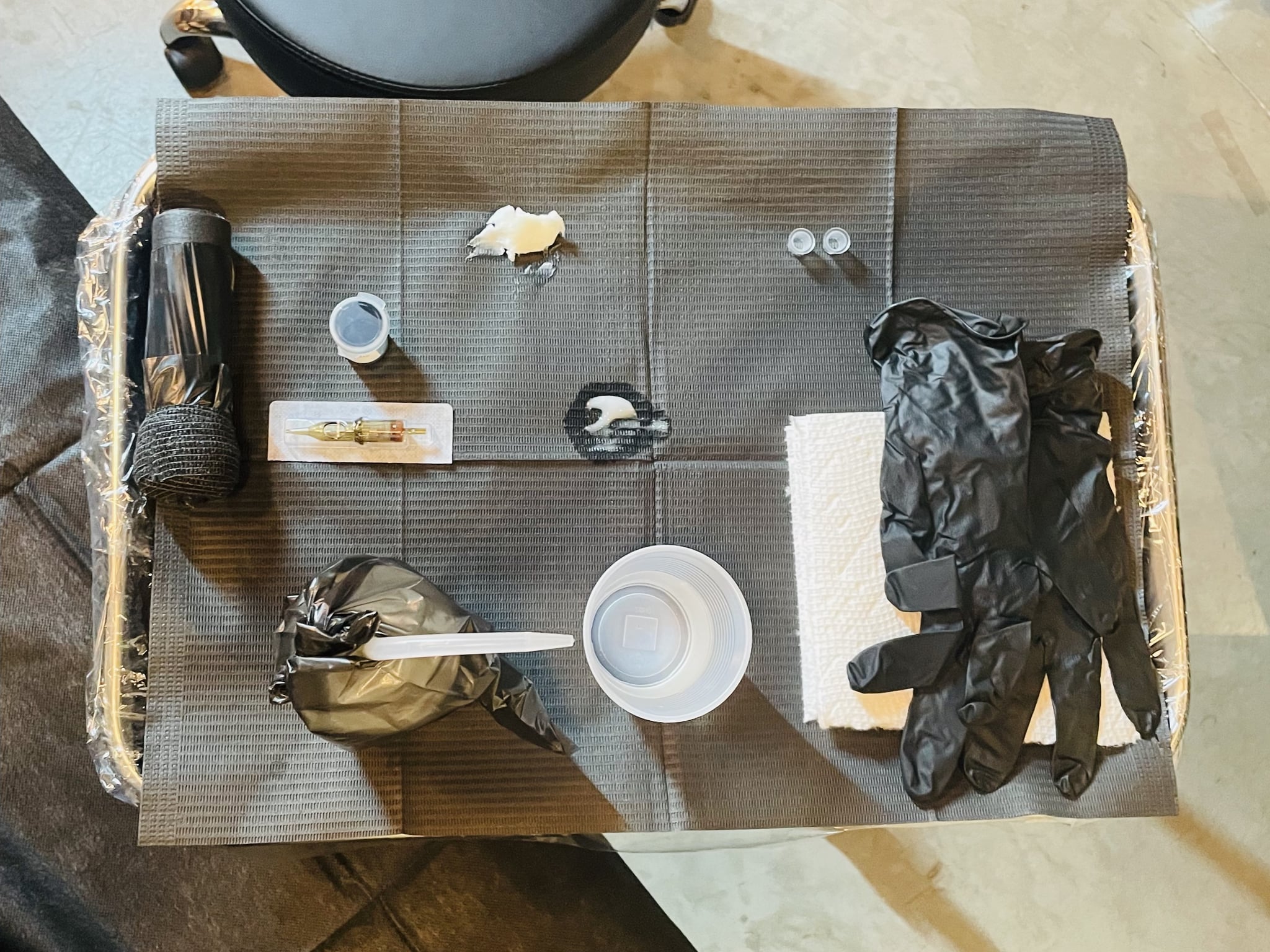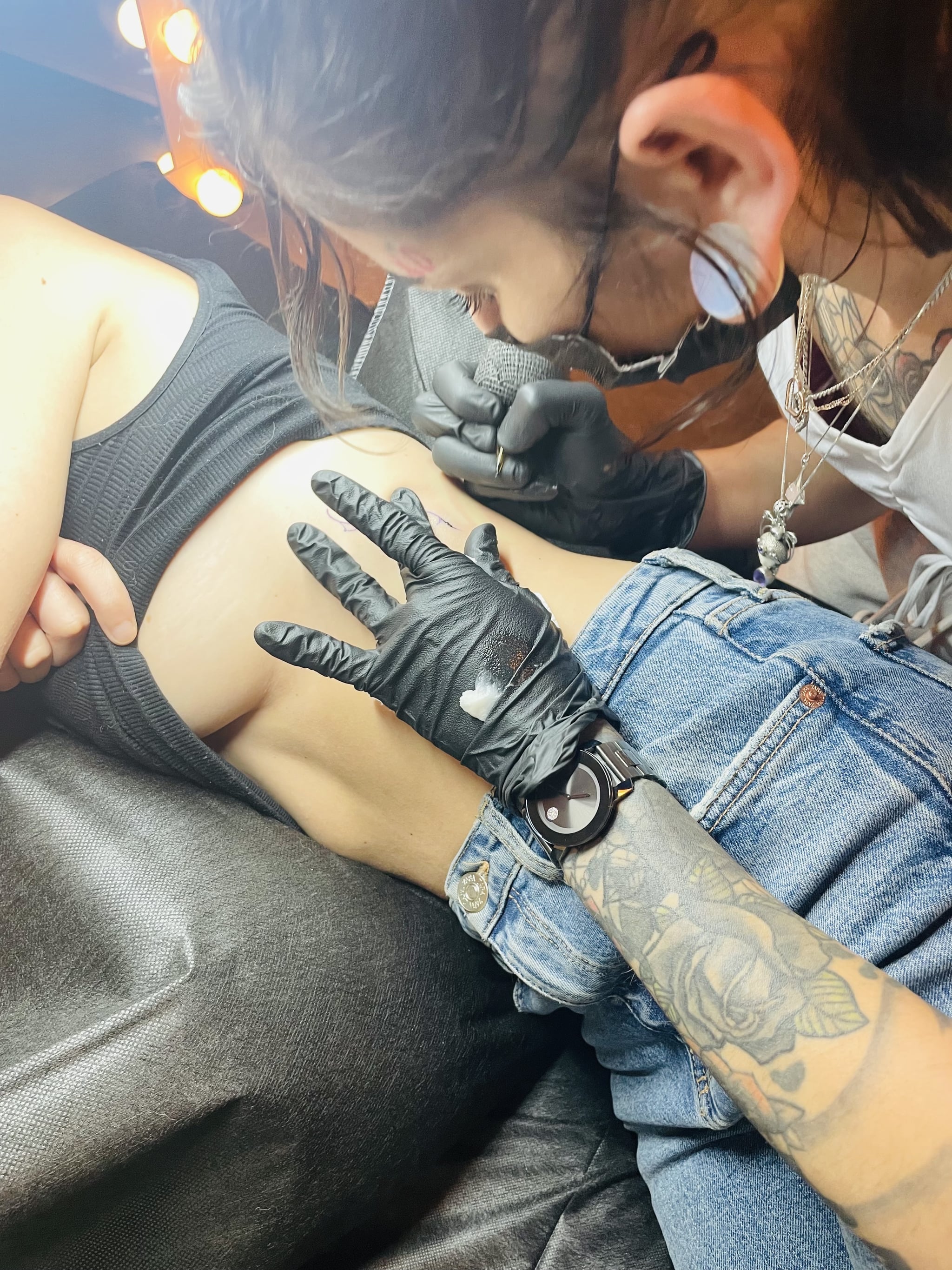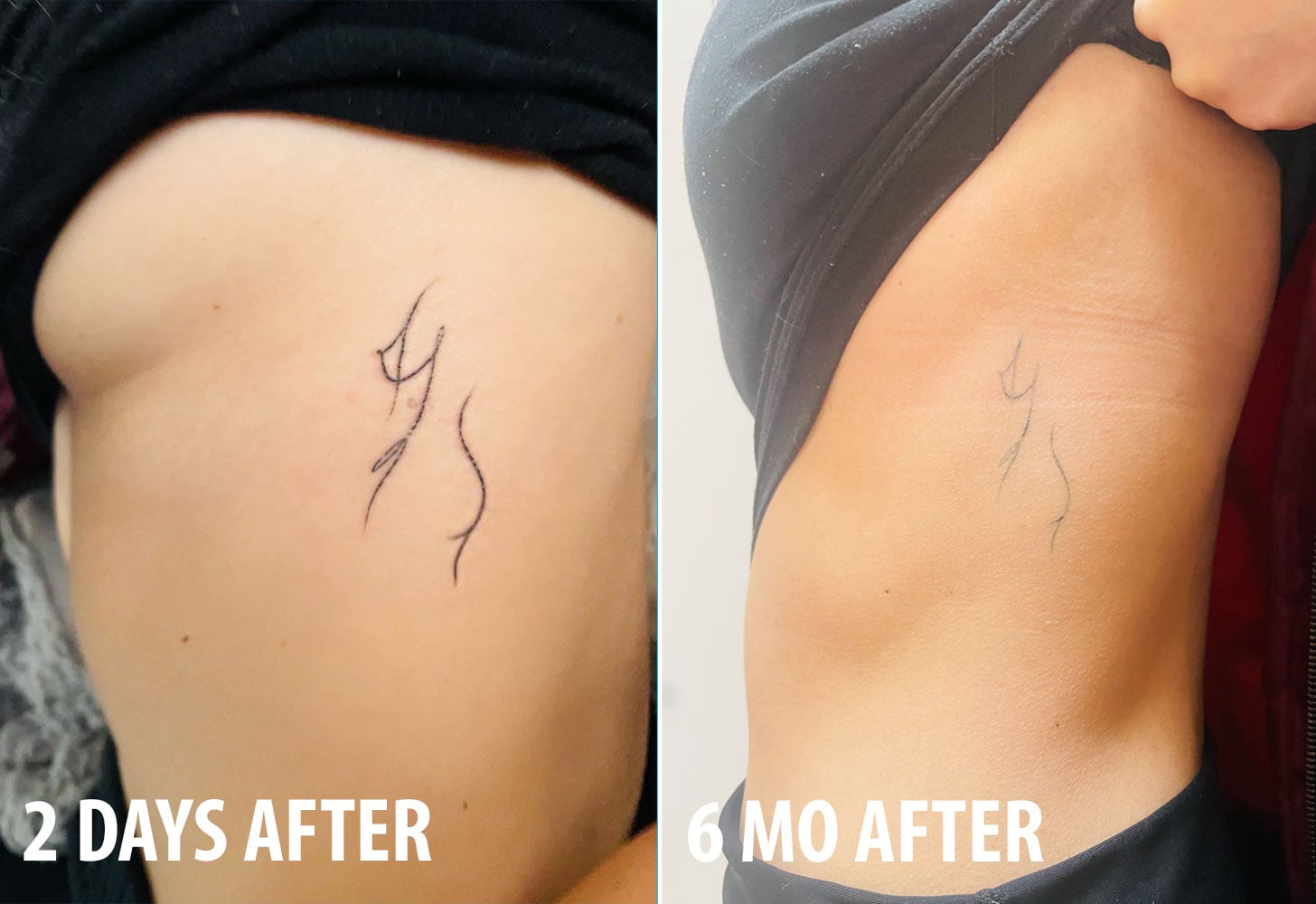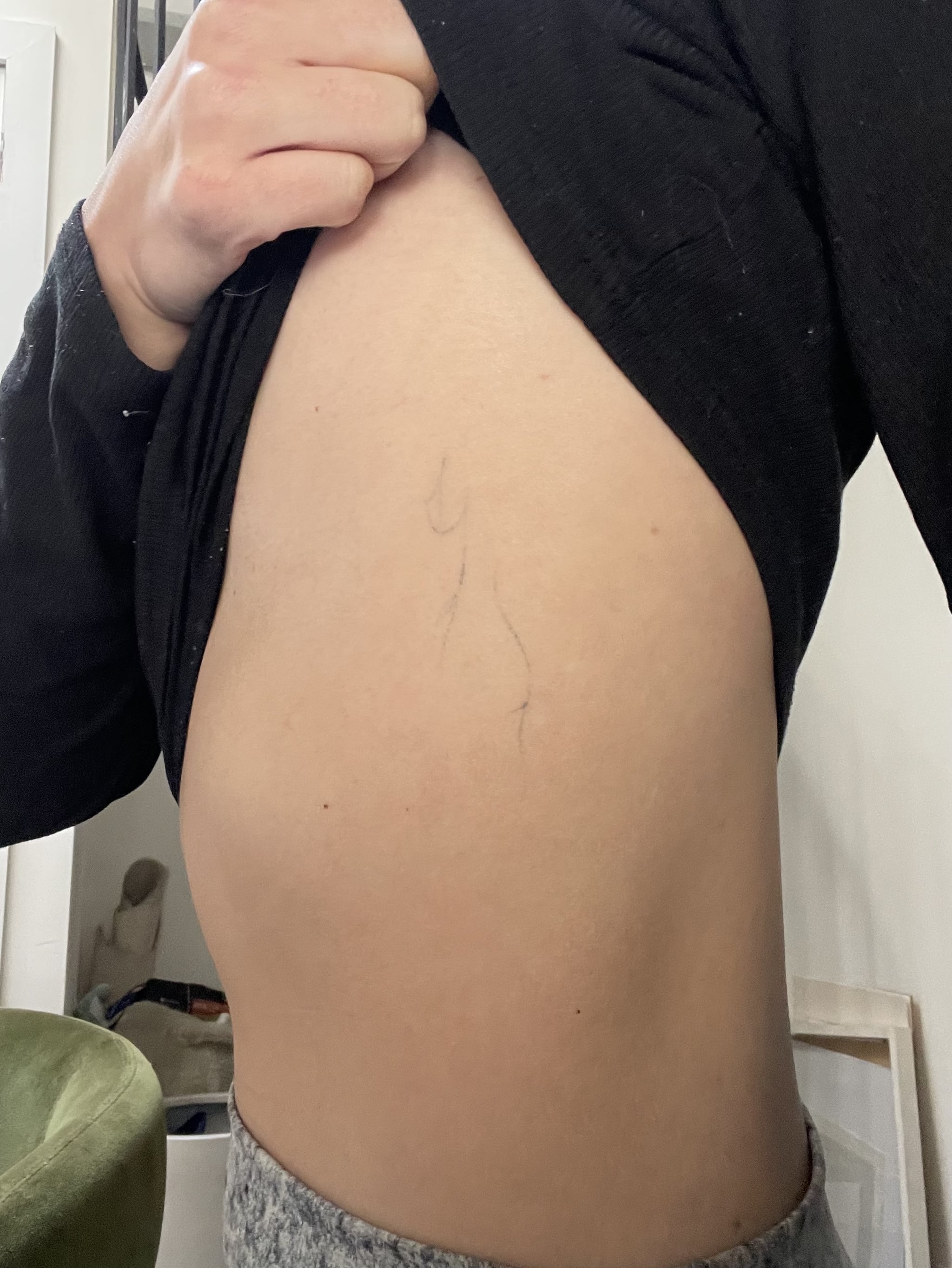I Got a "Made to Fade" Tattoo: See How It Disappeared Over Time

“Um, I have to ask,” the tattoo artist blinks in my direction, “Why did you choose this particular tattoo?”
She was standing above the man sitting next to me in the waiting area at Ephemeral Tattoo in Brooklyn with an iPad in hand. Blown up on the tiny screen was a cartoonishly large portrait of Chris Kirkpatrick (yes, that Chris Kirkpatrick from *NSYNC), of which he kindly requested be inked on his upper thigh. “Oh, he’s coming into town this weekend and I thought it would be funny,” the man replies. I join in on the collective laughs.
In theory, the idea of getting a pop culture tattoo — or someone else’s face, period — etched on your body might seem risky. (What if you meet this person and they disappoint you? What if they turn out to be a bonafide Bad Human?) But what if the design isn’t permanent? The latest made-to-fade technology in “ephemeral” tattoos means that’s no longer a pipe dream; the ink is designed to slowly break down over time, fully disappearing after 10 months to a year.
Here’s how it works: the proprietary ink is composed of small particles — made from medical-grade, bioabsorbable, and biocompatible polymers with high-quality pigments routinely used in foods, cosmetics, and other products, the company’s CEO Jeffrey Liu previously told POPSUGAR — that shrink over time. Like dissolvable stitches, your body releases them naturally.
Simply put, it’s a real tattoo sans the commitment — which means it’s precisely what I was looking for.
You see, I’ve had my share of experiences with ink I no longer wanted. (They say getting a tattoo with a partner is a kiss of death — the reason Winona and Johnny or Tyga and Kylie ended in disaster. I say: try telling that to a drunk girl in love.) This made the premise of a semipermanent design sound extra appealing.
As such, I found myself booking an appointment with artist Marissa Boulay, sitting next to the world’s most devoted *NSYNC fan, and going under the needle for my very first made-to-fade tattoo. Here’s how the whole thing went — and how the ephemeral ink faded over time.
How to Choose an Ephemeral Tattoo
In my mind, there were only two reasonable routes for picking a made-to-fade tattoo. The first is to get, like my friend at the studio, the wildest design you can think of. (“Honestly, I’m surprised more people aren’t doing crazy tattoos like this,” I remember his artist saying.) I considered this, weighing options like the word “TEMPORARY” or the middle finger. The second is to use the appointment as a “trial run” for a tattoo you already want, seeing how it looks in scale or on a particular part of the body before making it permanent.
I went with route numero two. My biggest fear was that the tattoo would look patchy or uneven after a few months, and I didn’t want to be left with flecks of (pigment) regret like in the past. So I chose a small design I knew wanted — a single-line silhouette of the female form — in a hidden part of my body (my left ribcage). Obviously, the road you choose is up to you.
What to Expect During the Ephemeral-Tattoo Process
What happens during an ephemeral appointment is similar to that of a regular tattoo appointment. You share your design idea with the artist via a handy online survey ahead of time, show up to the studio (the one I went to was in Brooklyn, but there are three other studios in San Francisco, Los Angeles, and Atlanta), and lie back on the leather tattoo chair under a ring light.
The tattooists are all vetted and legit, often coming from well-known studios across the city. Each is trained in shading techniques that work best with the made-to-fade ink (translation: that don’t overwork the skin), such as stippling, hatching, and etching. Like any other artist, they each have their own tattooing “style,” so you’ll want to check out the brand’s Instagram if you have a particular aesthetic in mind.
Otherwise, pretty much everything else is business as usual, from the tattoo gun to the equipment. The obvious distinction is the ink, which, as of right now, is only available in black. The bigger difference, in my opinion, was the pain level. Allow me to explain.
Do Ephemeral Tattoos Hurt?
Let me preface by saying that pain is relative, and how much a tattoo hurts depends on your tolerance as much as it does the tattoo’s placement. My pain tolerance is nowhere close to what Batman’s exoskeleton suit can withstand, but I’ve always considered it pretty high — and I’d say ephemeral tattoos are more painful than regular tattoos.
Boulay tells me that because ephemeral ink is a little lighter in pigment, artists have to tattoo the skin at a slower pace. They also have to press a smidge harder. “We just want to make sure it shows up,” she says. This is all to say that it hurt a little more than any of my other tattoos had, but it was still tolerable.
Ephemeral-Tattoo Aftercare
Immediately after my session, they applied a hydrocolloid bandage to my tattoo. Like the pimple patches you’d find on the market with the same technology, this is meant to draw out fluids during the healing process. I kept mine on for two days as directed (you can leave it on for up to four days if you’d prefer), fighting the urge to clean it after seeing the outline of my tattoo turn blue.
Boulay says the healing process for ephemeral tattoos can take longer than for regular tattoos (up to one week for the flaking process to pass, and then another four to six weeks for it to fully heal), but for the most part, proper tattoo aftercare is similar no matter where you go. Still, the team at Ephemeral will send you home with a free kit to keep your fresh ink clean and healthy.
How Long Do Ephemeral Tattoos Last?
The brand says an ephemeral tattoo will last anywhere from nine or 10 months to a year, although Boulay tells me that everyone’s skin has different physiology, so some people’s ink will fade faster than others’. Generally, however, it’s estimated that your ink will completely disappear after a year. I found that the design kept its saturated pigment up until the fourth month, at which point it began to gradually fade.
Ephemeral Tattoo Before and Afters: 6 Months
I first began to notice my tattoo start to fade after about the six month-mark, although I’ll admit the process was slow and steady. I’m told the ink tends to disappear faster when it’s in an area that experiences a lot of friction or contact with other materials, like clothing. Because I don’t wear bras often (if ever), and the tattoo is located on my rib cage, only time will tell how long it will last. Luckily, because it’s in a hidden placement, I’m not too bothered by the slow fade.
Ephemeral Tattoo Before and Afters: 1 Year, 6 Months
It’s been a full year and a half since I first went in for my ephemeral tattoo, and while the ink is significantly lighter, you can see it’s still there — like a shadow of the design it once was.
In full transparency, I was relieved when it started to faded; I’d decided — after giving the tattoo a cold, hard look — that the design looked a little . . . phallic. The part that was meant to be a woman’s arm ended up looking very far removed from an arm, and I quickly became ready for it to be off my body as soon as possible.
The good news is that’s the best part of getting an ephemeral tattoo — you get to experiment without any fear of consequences. (Siri, play *NSYNC’s “No Strings Attached.”)
Source: Read Full Article




